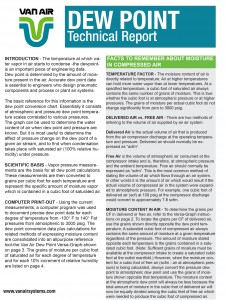What is Dew Point?
The term Dew Point comes up several times per day when our application engineers are talking with customers. Asking customers questions about their applications that require compressed air & gas drying equipment help us specify the right products, and the most cost-effective dew point for their facility.
But really, what is dew point? The pure definition is “dew point is the temperature where moisture stars to condense”.
You probably hear dew point mentioned on TV when you watch the weather forecast. In the summer months the ambient temperatures are much hotter and the air is more humid, therefore the dew points are much higher. The weather forecaster may say the dew point overnight will be 72°F. What does this mean? Remember the definition of dew point stated above. Overnight the ground cools as do the leaves on trees and all hard surfaces like your automobile and patio furniture. If the ambient temperature overnight drops say to 68°F, the ground, trees, and hard surfaces will cool to that temperature which is below the 72°F dew point temperature. Condensation occurs because of the temperature difference and dew forms on these cooler surfaces.
Why is dew point so important when talking about compressed air and gas drying equipment? We want to prevent “dew” from forming inside piping and valves. Typically, ambient temperatures vary in a manufacturing plant and there may even be compressed air lines running outdoors or into air conditioned and refrigerated areas. Customers want to make sure they are not condensing moisture that will drop out in their compressed air lines that feed their machinery and processes. The only way to eliminate condensation/water in compressed air distribution piping is to dry the compressed air to a dew point that is at least 10°F below the lowest ambient temperature that the piping is exposed to.
As an example, if a manufacturing facility uses a refrigerated dryer and there is compressed air distribution piping that runs outdoors this would be a problem in colder fall and winter months. A refrigerated dryer produces a 35-38°F dew point, meaning it dries the compressed air to that specific dew point range. If the outdoor piping is exposed to temperatures below 35°F then condensation and freezing will occur in the piping and valves. So, what would you do in this scenario? You could replace the refrigerated dryer with a regenerative dryer. A regenerative dryer produces a -40°F dew point, so it would eliminate the problem. This however would be overkill and extremely expensive. Remember, all we need to do is dry the compressed air to a dew point that is 10°F below the lowest ambient temperature that piping is exposed to. By simply doing this we will eliminate any condensation or freezing issues. In this example, a better solution is to install a point of use deliquescent dryer outdoors to protect the piping, valves, etc that are exposed to the low ambient temperatures. A deliquescent dryer has no moving parts and requires no electrical power. It will dry the compressed air to a dew point low enough to protect the outdoor piping from freezing.
Some customers will call us and simply state they want a dryer that will give them a -40°F dew point. The customer may know what they “want”, but is it what they really “need”? Our task is to challenge these customers with questions about their application, facility, piping distribution, ambient conditions, etc. so we can develop the most cost-effective solution for them and get the dryer that gives them the dew point they really “need”.
If you are having issues with moisture in your compressed air lines at your facility please contact us for recommendations on how Van Air Systems can solve your problems.
 Download our DewPoint Technical Report today.
Download our DewPoint Technical Report today.
